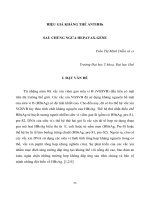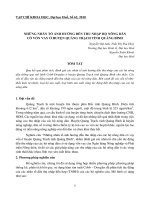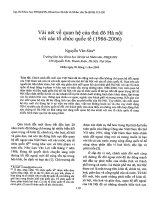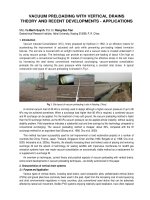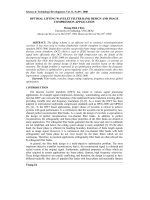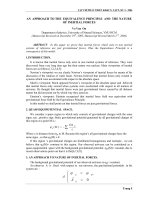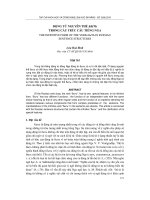Báo cáo nghiên cứu khoa học: " AN APPROACH TO THE EQUIVALENCE PRINCIPLE AND THE NATURE OF INERTIAL FORCES" pptx
Bạn đang xem bản rút gọn của tài liệu. Xem và tải ngay bản đầy đủ của tài liệu tại đây (342.64 KB, 6 trang )
TẠP CHÍ PHÁT TRIỂN KH&CN, TẬP 9, SỐ 5 - 2006
Trang 5
AN APPROACH TO THE EQUIVALENCE PRINCIPLE AND THE NATURE
OF INERTIAL FORCES
Vo Van On
Department of physics, University of Natural Sciences, VNU-HCM
(Manuscript Received on December 19
th
, 2005, Manuscript Revised March 2
th
, 2006)
ABSTRACT: In this paper we prove that inertial forces which exist in non inertial
systems of reference are just gravitational forces. Thus the Equivalence Principle is a
consequence of this model.
1.INTRODUCTION.
It is known that inertial forces only exist in non inertial systems of reference. They were
discovered from very long time ago but their nature was unclear. Main viewpoints of inertial
forces are as follows [1,2,3,4,5]:
Newton’s viewpoint: we see clearly Newton’s viewpoint of inertial forces by means of his
discussion of the rotation of water basin. Newton believed that inertial forces only existed in
systems which were accelerated with respect to his absolute space.
Mach’s viewpoint: Mach opposed Newton’s viewpoint of the absolute space and believed
that inertial forces only existed when systems were accelerated with respect to all matters of
universe. He thought that inertial forces were just gravitational forces caused by all distance
matter but did not point out by which way they acted on.
Einstein’s viewpoint: Einstein recognized that inertial force field was equivalent with
gravitational force field by the Equivalence Principle.
In this model we shall point out that inertial forces are just gravitational forces.
2. QUASI-EQUIPOTENTIAL SPACE.
We consider a space region in which only consists of gravitational charges with the same
signs, say , positive sign. Static gravitational potential generated by all gravitational charges of
this region at a point M is :
∑
−=
i
i
gi
g
r
Gm
M )(
ϕ
Where r
i
is distance from m
gi
to M. Because this region’s all gravitational charges have the
same signs , so that ϕ
g
(M) ≠ 0.
If this region ‘s gravitational charges are distributed homogeneous and isotropic , we can
believe that ϕ
g
(M)= constant in this region. Our observed universe can be considered as a
quasi-equipotential space with the background gravitational potential ϕ
g0
(M)= constant, due to
recent observations point out that it is flat[6,7,8,9].
3. AN APPROACH TO NATURE OF INERTIAL FORCES.
The background gravitational potential of our observed universe is ϕ
g0
= constant.
An observer A is fixed with respect to our universe ,the gravitational potentials in his
system are :
⎪
⎩
⎪
⎨
⎧
=
=
0
g
gog
A
A
r
ϕϕ
Science & Technology Development, Vol 9, No.5 - 2006
Trang 6
An different observer B stands in a system which moves with velocity V with respect to
A on X- direction ( V is measured by A ). Gravitational potentials in system of B, following
the Lorentz ‘s transformation , are :
⎪
⎪
⎪
⎪
⎩
⎪
⎪
⎪
⎪
⎨
⎧
=Α=
−
=
−
=
0'
1
'
1
'
'
2
0
2
2
gz
gy
g
gx
g
g
A
c
AB
β
ϕ
ν
β
ϕ
ϕ
from above formulas, we have :
⎪
⎩
⎪
⎨
⎧
′
=
′
∂
∂
+
′
−=
'
'
'
''
gg
g
gg
AlcurB
t
A
dgraE
r
r
r
r
ϕ
If B is fixed or moves uniformly in a straight line with respect to A , we have :
⎪
⎩
⎪
⎨
⎧
=
′
=
=
′
∂
∂
+
′
−=
0''
0
'
''
gg
g
gg
AlcurB
t
A
dgraE
r
r
r
r
ϕ
because V does not depend on t .
If B is accelerated with respect to A ,i.e. :
2
22
1
c
ta
at
v
+
= ,
0
=
o
v we have :
t
.
t
t
x
.
t
x
t
;
t
.
x
t
x
.
x
x
x
:with
0EE,
t
'A
x
'E
gzgy
gxg
gx
∂
∂
′
∂
∂
+
∂
∂
′
∂
∂
=
′
∂
∂
∂
∂
′
∂
∂
+
∂
∂
′
∂
∂
=
′
∂
∂
=
′
=
′
′
∂
∂
+
′
∂
′
∂
−=
ϕ
and
2
2
2
2
2
1
;
1
c
v
x
c
v
t
t
c
v
vtx
x
−
+
′
=
−
+
′
=
Put
BAE
gx
+−=
′
(1)
Where
DC
tx
t
xx
x
x
A
ggg
+=
∂
′
∂
′
∂
∂
+
∂
′
∂
′
∂
∂
=
′
∂
′
∂
−≡
)(
ϕ
ϕ
ϕ
(2)
TẠP CHÍ PHÁT TRIỂN KH&CN, TẬP 9, SỐ 5 -2006
Trang 7
With
0.)1(
2/1
2
2
−
−=
∂
′
∂
′
∂
∂
≡
c
v
xx
x
C
g
ϕ
= 0 due to
gx
ϕ
′
is independent with respect to x.
And
t
v
v
c
v
c
v
tx
t
D
gg
∂
∂
∂
′
∂
−=
∂
′
∂
′
∂
∂
=
−
ϕ
ϕ
2/1
2
2
2
)1( (3)
We have
0
2
2/3
2
2
0
2/1
2
2
).2.()1(
2
1
.)1(
gg
g
c
v
c
v
c
v
vv
ϕϕ
ϕ
−−−=−
∂
∂
=
∂
′
∂
−−
2/3
2
2
2
0
)1(
−
−=
c
v
c
v
g
ϕ
(4)
And
at
c
ta
ctactaactaat
tt
v
2
2
2/32222/12222/1222
2
.)/1).(
2
1
()/1.(])/1.([
−−−
+−++=+
∂
∂
=
∂
∂
]//1[)/1[()/1.(
2222222/32222/3222
ctactactactaa −+++=
−−
2/3
2
22
)1.(
−
+=
c
ta
a
(5)
Thus A becomes :
2/3
2
22
2/3
2
2
2
0
2/1
2
2
2
)1(.)1( )1(
−−−
+−−==
c
ta
a
c
v
c
v
c
v
c
v
DA
g
ϕ
2
2
2/3
2
22
2
2
2
2
0
)1()1.(.
c
v
c
ta
c
v
a
c
g
−−
+−=
ϕ
(6)
Then we account B:
FE
t
A
t
t
x
A
t
x
t
A
B
gxgx
+=
∂
′
∂
′
∂
∂
+
∂
′
∂
′
∂
∂
=
′
∂
′
∂
=
Where:
00.)1.(
2/1
2
2
=−=
∂
′
∂
′
∂
∂
=
−
c
v
v
x
A
x
t
E
gx
due to
gx
A
′
also is independent with respect to x.
And:
v
A
c
ta
c
v
a
t
v
v
A
c
v
t
A
t
t
F
gxgxgx
∂
′
∂
+−=
∂
∂
∂
′
∂
−=
∂
′
∂
′
∂
∂
≡
−−− 2/3
2
22
2/1
2
2
2/1
2
2
)1()1.()1( (7)
We have :
])2.()1).((
2
1
()1[(])1([
2
2/3
2
2
2/1
2
2
2
0
2/1
2
2
0
2
v
c
v
c
v
c
v
cc
v
c
v
vv
A
g
g
gx
−−−+−=−
∂
∂
=
∂
′
∂
−−−
ϕ
ϕ
]1[)1(])1()1[(
2
2
2
2
2/3
2
2
2
0
2/3
2
2
2
2
2/1
2
2
2
0
c
v
c
v
c
v
cc
v
c
v
c
v
c
gg
+−−=−+−=
−−−
ϕ
ϕ
=
2/3
2
2
2
0
)1(
−
−
c
v
c
g
ϕ
(8)
Thus
Science & Technology Development, Vol 9, No.5 - 2006
Trang 8
B=
2/1
2
2
2
0
2/3
2
2
2/3
2
22
)1()1()1.(
−−−
−−+==
′
∂
′
∂
c
v
cc
v
c
ta
aF
t
A
ggx
ϕ
(9)
From (1),(6),(9), we have:
=+−=
′
BAE
gx
2
2
2/3
2
22
2
2
2
2
0
)1()1.(.
c
v
c
ta
c
v
a
c
g
−−
+−−
ϕ
+
2/1
2
2
2
0
2/3
2
2
2/3
2
22
)1()1()1.(
−−−
−−++
c
v
cc
v
c
ta
a
g
ϕ
=
]1[)1()1.(.
2
2
2/3
2
22
2
2
2
2
0
c
v
c
ta
c
v
a
c
g
−+−
−−
ϕ
=
2/3
2
22
1
2
2
2
0
)1()1.(.
−−
+−
c
ta
c
v
a
c
g
ϕ
(10)
From
2
22
1
c
ta
at
v
+
= so that
1
2
22
2
2
)1(1
−
+=−
c
ta
c
v
(10) becomes:
=
′
gx
E
2/1
2
2
2
0
)1.(.
−
−
c
v
a
c
g
ϕ
We also have:
0=
′
g
B
r
due to
g
A
′
r
is independent with respect to x’,y’,z’.
At zero order of v
2
/c
2
, we have :
a
c
E
g
gx
)('
2
0
ϕ
=
Gravitational force acts on a particle with gravitational charge m
g
in system B is:
F’
gx
= m
g
E’
gx
=
am
c
g
g
)(
2
0
ϕ
.
This force just is inertial force in system B when we recognize that :
F’
gx
=
am
c
g
g
)(
2
0
ϕ
=-
am
i
Or
2
0
c
m
m
g
g
i
ϕ
−=
From experiments , we have :
1≅
g
i
m
m
so 1
2
0
−≅
c
g
ϕ
.
Thus gravitational field exists in non inertial systems of reference is :
TẠP CHÍ PHÁT TRIỂN KH&CN, TẬP 9, SỐ 5 -2006
Trang 9
a
c
v
E
gx
.
1
1
'
2
2
−
−≅
Where a is acceleration of system.
4.DISCUSIONS
From above results we find that Newton, Mach and Einstein‘s viewpoints of inertial forces
are satisfied in this model.
Firstly, in this model inertial forces ( uniform gravitational forces) exist only in systems
which are accelerated with respect to “the background gravitational potential font” of universe
ϕ
g0
. Whether this font is just “the absolute space of Newton”! However the background font is
not actually absolute but vanishes if all matters do not exist.
Secondly, in this model inertial forces are just uniform gravitational forces which are
caused by all matter of universe by means of the background font
ϕ
g0.
This satisfies Mach ‘s
viewpoint and it also points out way that all matters of universe cause inertial forces.
Finally, in this model inertial forces field are just uniform gravitational field as Einstein’s
the principle of equivalence. However in this model inertial forces also vanish at infinite when
the background font vanishes. This uniform gravitational field is not equivalent to central
gravitational field by tidal forces so that the principle of equivalence holds only for small
regions of space. We also find that when the system of frame moves with velocity approaching
c, inertial forces will be infinite.
Acknowledgements:
We extend our thanks to the professors in laboratory of theoretical
physics of University of Natural Sciences, VNU-HCM, especially to the professor NGUYEN
NGOC GIAO for helpful remarks .
MỘT TIẾP CẬN ĐẾN NGUYÊN LÝ TƯƠNG ĐƯƠNG VÀ BẢN CHẤT CỦA
CÁC LỰC QUÁN TÍNH
Võ Văn Ớn
Khoa Vật Lý-Đại Học Khoa Học Tự Nhiên – ĐHQG-HCM
TÓM TẮT : Trong bài báo này chúng tôi chứng minh rằng các lực quán tính tồn tại
trong các hệ qui chiếu phi quán tính chính là các lực hấp dẫn.Như vậy nguyên lý tương đương
là một hệ quả của mô hình này.
REFERENCES
[1]. Nguyen Ngoc Giao, The Theory of Gravitational Field (The General Theory of
Relativity),
Library of University of Natural Sciences, Ho Chi Minh city (in
Viertnamese), 1999.
[2]. R.Alder, M.Bazin, M.schiffer, Introduction to General Relativity, Mc Graw-hill, New
York, 1965.
Science & Technology Development, Vol 9, No.5 - 2006
Trang 10
[3]. A.Einstein, The Meaning of Relativity, Princeton University Press, Princeton, N.J.,
1964.
[4].
V.Fock, The Theory of Space, Time, and Gravitation, trans. By N.N. Kemmer, 2nd
rev.ed., Macmilan, New York, 1964.
[5].
S.Weinberg, Gravitation and Cosmology: Principles and Applications of General
Theory of Relativity
, Copyright 1972 by John Wiley & Sons, Inc
[6].
P.de Bernardis et al, Nature, 404, 955, 2000.
[7].
S.Hanany et al, Astrophys.J.545, L5, 2000.
[8].
C.b.Netterfield et al, astro-ph/0104460
[9].
C.Pryke et al, astro-ph/0104490
